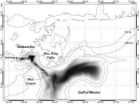(Press-News.org) COLUMBIA, Mo. – The world's oceans cover more than 72 percent of the earth's surface, impact a major part of the carbon cycle, and contribute to variability in global climate and weather patterns. However, accurately predicting the condition of the ocean is limited by current methods. Now, researchers at the University of Missouri have applied complex statistical models to increase the accuracy of ocean forecasting that can influence the ways in which forecasters predict long-range events such as El Nińo and the lower levels of the ocean food chain—one of the world's largest ecosystems.
"The ocean really is the most important part of the world's environmental system because of its potential to store carbon and heat, but also because of its ability to influence major atmospheric weather events such as droughts, hurricanes and tornados," said Chris Wikle, professor of statistics in the MU College of Arts and Science. "At the same time, it is essential in producing a food chain that is a critical part of the world's fisheries."
The vastness of the world's oceans makes predicting its changes a daunting task for oceanographers and climate scientists. Scientists must use direct observations from a limited network of ocean buoys and ships combined with satellite images of various qualities to create physical and biological models of the ocean. Wikle and Ralph Milliff, a senior research associate at the University of Colorado, adopted a statistical "Bayesian hierarchical model" that allows them to combine various sources of information as well as previous scientific knowledge. Their method helped improve the prediction of sea surface temperature extremes and wind fields over the ocean, which impact important features such as the frequency of tornadoes in tornado alley and the distribution of plankton in coastal regions—a critical first stage of the ocean food chain.
"Nate Silver of The New York Times combined various sources of information to understand and better predict the uncertainty associated with elections," Wikle said. "So much like that, we developed more sophisticated statistical methods to combine various sources of data—satellite images, data from ocean buoys and ships, and scientific experience—to better understand the atmosphere over the ocean and the ocean itself. This led to models that help to better predict the state of the Mediterranean Sea, and the long-lead time prediction of El Nińo and La Nińa. Missouri, like most of the world, is affected by El Nińo and La Nińa (through droughts, floods and tornadoes) and the lowest levels of the food chain affect us all through its effect on Marine fisheries."
El Nińo is a band of warm ocean water temperatures that periodically develops off the western coast of South America and can cause climatic changes across the Pacific Ocean and the U.S. La Nińa is the counterpart that also affects atmospheric changes throughout the country. Wikle and his fellow researchers feel that, through better statistical methods and models currently in development, a greater understanding of these phenomena and their associated impacts will help forecasters better predict potentially catastrophic events, which will likely be increasingly important as our climate changes.
INFORMATION:
Wikle's study, "Uncertainty management in coupled physical-biological lower trophic level ocean ecosystem models," was funded in part by the National Science Foundation and was published in Oceanography and Statistical Science.
New statistical models could lead to better predictions of ocean patterns
Could lead to better weather predictions including weather, climate and ecosystems
2014-03-18
ELSE PRESS RELEASES FROM THIS DATE:
Early detection of childhood eye cancer doesn't always improve survival, prevent eye loss
2014-03-18
For the most common form of childhood eye cancer, unilateral retinoblastoma, shortening the time from the first appearance of symptoms to diagnosis of disease has no bearing on survival or stage of the disease, according to a study by researchers at Columbia University Mailman School of Public Health in partnership with the Hospital Infantil de Mexico. The results appear online in the journal Cancer Epidemiology, Biomarkers & Prevention.
Because retinoblastoma is easily detectable by shining a light into a child's eye—often as a "cat's eye" reflection revealed through ...
The precise reason for the health benefits of dark chocolate: Mystery solved
2014-03-18
DALLAS, March 19, 2014 — The health benefits of eating dark chocolate have been extolled for centuries, but the exact reason has remained a mystery –– until now. Researchers reported here today that certain bacteria in the stomach gobble the chocolate and ferment it into anti-inflammatory compounds that are good for the heart.
Their findings were unveiled at the 247th National Meeting & Exposition of the American Chemical Society (ACS), the world's largest scientific society. The meeting, attended by thousands of scientists, features more than 10,000 reports on new advances ...
Building heart tissue that beats
2014-03-18
DALLAS, March 18, 2014 — When a heart gets damaged, such as during a major heart attack, there's no easy fix. But scientists working on a way to repair the vital organ have now engineered tissue that closely mimics natural heart muscle that beats, not only in a lab dish but also when implanted into animals. They presented their latest results at the 247th National Meeting & Exposition of the American Chemical Society (ACS), the world's largest scientific society.
The talk was one of more than 10,000 being presented at the meeting, which continues here through Thursday.
"Repairing ...
Bees capable of learning feats with tasty prize in sight
2014-03-18
They may have tiny brains, but bumblebees are capable of some remarkable learning feats, especially when they might get a tasty reward, according to two studies by University of Guelph researchers.
PhD student Hamida Mirwan and Prof. Peter Kevan, School of Environmental Sciences, are studying bees' ability to learn by themselves and from each other.
In the first study, published in February in Animal Cognition, the researchers found bees capable of learning to solve increasingly complex problems.
The researchers presented bees with a series of artificial flowers that ...
Sauder research shows why innovation takes a nosedive
2014-03-18
A new UBC study reveals that corporate leaders are victims of herd mentality when adopting new innovations, sometimes with deadly consequences.
The paper, by Sauder School of Business Associate Professor Marc-David L. Seidel and INSEAD Professor Henrich R. Greve, shows leaders tend to pursue innovations, even as complex as airplanes, based on early adoption by competitors not close scrutiny of the technical merits.
"Business leaders tend to panic when new innovations are about to hit the market. They scramble to buy an apparent early leader," says Seidel. "Sometimes ...
Stanford researchers survey protein family that helps the brain form synapses
2014-03-18
Neuroscientists and bioengineers at Stanford are working together to solve a mystery: how does nature construct the different types of synapses that connect neurons -- the brain cells that monitor nerve impulses, control muscles and form thoughts.
In a paper published in the Proceedings of the National Academy of Sciences, Thomas C. Südhof, M.D., a professor of molecular and cellular physiology, and Stephen R. Quake, a professor of bioengineering, describe the diversity of the neurexin family of proteins.
Neurexins help to create the synapses that connect neurons. Think ...
TGen-led study spotlights dog DNA role in developing new therapies for human cancers
2014-03-18
PHOENIX, Ariz. — March 17, 2014 — Using genomic analysis to study cancer in dogs can help develop new therapies for humans with cancer, according to a proof-of-concept study led by the National Cancer Institute (NCI) and the Translational Genomics Research Institute (TGen).
Pure-breed dogs, whose genetics have been standardized by hundreds of years of human intervention, provide highly predictable genetic models useful in designing clinical trials, in which specific drugs are matched to the molecular profiles of human patients, according to the study published today in ...
Kessler Foundation researchers link body temperature to relapsing-remitting MS and fatigue
2014-03-18
West Orange, NJ. March 18, 2014. Kessler Foundation researchers have demonstrated for the first time ever that body temperature is elevated endogenously in relapsing-remitting multiple sclerosis (RRMS) and linked to worse fatigue. The article was published ahead of print on Feb. 21, 2014 in Archives of Physical Medicine & Rehabilitation. Sumowski J, Leavitt V: Body temperature is elevated and linked to fatigue in relapsing-remitting multiple sclerosis, even without heat exposure. doi:10.1016/j.apmr.2014.02.004.
Researchers measured body temperature in 50 patients with ...
NIST chips help BICEP2 telescope find direct evidence of origin of the universe
2014-03-18
The view back in time—way back to the origins of the universe—just got clearer. Much clearer.
A team of U.S. cosmologists using the BICEP2 telescope at the South Pole announced this week that they have discovered the first direct evidence of the rapid inflation of the universe at the dawn of time, thanks in part to technology developed and built by the National Institute of Standards and Technology (NIST).
The BICEP2 camera relies, in part, on the extraordinary signal amplification made possible by NIST's superconducting quantum interference devices (SQUIDs).
The ...
NRL models Deepwater Horizon oil spill
2014-03-18
Dr. Jason Jolliff is an oceanographer with the U.S. Naval Research Laboratory (NRL). "The emphasis here," he says, "is on developing models of the ocean environment to help the naval warfighter." His most recent paper, published in Ocean Modeling (March 2014), shows NRL can also forecast where oil will go following a major spill.
"If you're going to do forecasting," he says, "you have to get the ocean circulation correct. It's fundamental to all else." Jolliff plugged the distribution of surface oil following the 2010 Deepwater Horizon oil spill—when it was still well ...
LAST 30 PRESS RELEASES:
Signature patterns of brain activity may help predict recovery from traumatic brain injury
Dresden study uncovers new key mechanism in cancer cells
New species are now being discovered faster than ever before, study suggests
Cannabis-based products show limited short-term benefit for chronic pain, with increased risk of adverse effects
Cannabis products with more THC slightly reduce pain but cause more side effects
Clearing the brain of aging cells could aid epilepsy and reduce seizures
Brain injuries linked with potential risk of suicide, new study finds
New technique lights up where drugs go in the body, cell by cell
New study finds movement of fishing fleets can reveal shifts in marine ecosystems
Embargoed: New evidence points to potential treatment for vascular dementia
Study uncovers disrupted brain balance in alcohol dependence
Working in groups can help Republicans and Democrats agree on controversial content moderation online
Structural findings reveal how distinct GPCR ligands create different levels of activation
Anything-goes “anyons” may be at the root of surprising quantum experiments
UC review: Maximizing workplace opportunity for veterans
From generation to complex control: Metasurfaces make perfect vortex beams "within reach"
Thin-film lithium niobate-based detector: recent advances and perspectives
Exploring why some people may tend to persistently make bad choices
How cells balance their protein levels
Nirsevimab vs RSVpreF vaccine for RSV–related hospitalization in newborns
Effectiveness and impact of maternal RSV immunization and nirsevimab on medically attended RSV in US children
AI gives scientists a boost, but at the cost of too many mediocre papers
Next-generation vision model maps tree growth at sub-meter precision
Genes aren’t destiny for inherited blindness, study shows
MIT study: High-fat diets make liver cells more likely to become cancerous
Exposure to multiple fine particulate matter components and incident depression in the US Medicare population
Risk of burdensome health care spending over time in the US
Nirsevimab against hospitalizations and emergency department visits for lower respiratory tract infection in infants
New microfluidics technology enables highly uniform DNA condensate formation
A new strategy for immune tolerance
[Press-News.org] New statistical models could lead to better predictions of ocean patternsCould lead to better weather predictions including weather, climate and ecosystems





